Collective Bargaining 5: Bargaining Techniques - Page 3
Revised
Learn effective documentation and argumentation strategies to strengthen your union's position during collective bargaining negotiations.

Contract Interpretation Standards
Reviewed
This publication outlines standards for interpreting collective bargaining agreements, focusing on arbitration principles and contract language clarity.

How Broadband Adoption and Availability Impacted Rural Employment During COVID-19
New
Learn how broadband affected rural employment rates before and during the COVID-19 pandemic.
Collective Bargaining 1: Historical Models of Collective Bargaining in the U.S. - Page 3
Revised
Employers ability to pay
Product market factors
Collective Bargaining 1: Historical Models of Collective Bargaining in the U.S. - Page 6
Revised
Avoidance of competitive unionism Avoidance of competitive unionism
Union bargaining strength is also weakened by wage competition between more than one union in each industry or with a particular employer.
Collective Bargaining 3: Effective Negotiations, Background Information - Page 2
Revised
Research agenda Research agenda
Early in the bargaining process, a local union may want to develop a research agenda to gather data useful in negotiations.

Collective Bargaining 5: Bargaining Techniques
Revised
In this section, some of the major techniques and tactics relevant to the actual bargaining sessions with management are discussed. Visit our site today.
Collective Bargaining 5: Bargaining Techniques - Page 4
Revised
Caucus
An important tactic in the collective bargaining process is the effective use of a caucus. A caucus is the opportunity for the parties to withdraw temporarily from direct negotiations one another. A caucus can and should be used in several different situations to make sure that negotiations are progressing in an appropriate manner.

Forcing Bulbs for Indoor Bloom
Reviewed
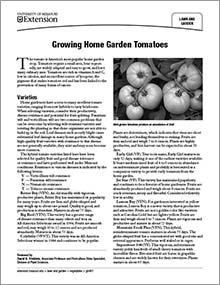
Growing Home Garden Tomatoes
Revised
Tomatoes are a popular home garden crop. They require little area, bear repeatedly, are easy to grow and have many culinary uses. Learn about various varieties and get tips for growing tomatoes in this guide.

Growing Herbs at Home
Reviewed
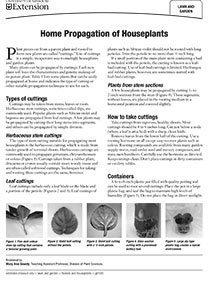
Home Propagation of Houseplants
Reviewed
Plant pieces cut from a parent plant and rooted to form new plants are called “cuttings.” Use of cuttings is a simple, inexpensive way to multiply houseplants and garden plants.
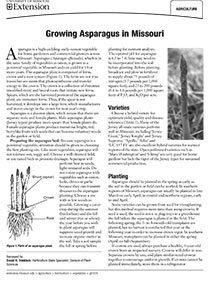
Growing Asparagus in Missouri
Reviewed
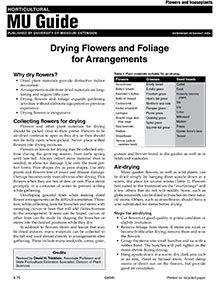
Drying Flowers and Foliage for Arrangements
Reviewed
Create distinctive indoor decorations by drying flowers and foliage. Air-drying, pressing, using dessicants, microwave oven-drying and freeze-drying methods plus preserving foliage with glycerin are covered in this illustrated MU Extension guide.
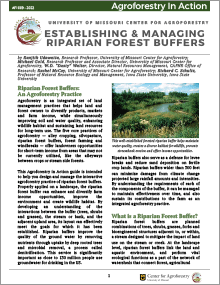
Establishing and Managing Riparian Forest Buffers
Revised
Learn how to design and manage the interactive agroforestry practice of riparian forest buffers.
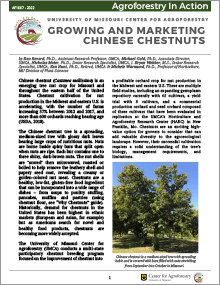
Growing Chinese Chestnuts in Missouri
Revised
Editor's note
This page currently contains only the introductory section of this guide. For the entire text, please download the PDF.

5 Steps to Buying Meat Direct From the Farm
New
If you are interested in buying meat from a local farmer, in quarters or halves, review these five considerations: how much meat your family can consume and what cuts to buy, sourcing an animal, finding a local meat processor, costs, and timing.

Days Suitable for Fieldwork in Missouri
Revised
Learn the number of days Missouri farms have available per week—due to weather and soil conditions—for tillage, planting, chemical application and harvest activities.
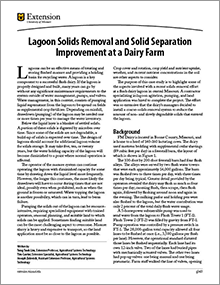
Lagoon Solids Removal and Solid Separation System Improvement at a Dairy Farm
Reviewed
Explore methods for managing lagoon solids in flush dairy systems, including removal techniques and solid separation system improvements.
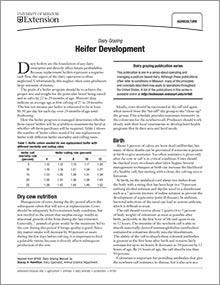
Dairy Grazing: Heifer Development
Revised
Heifers are the foundation of any dairy enterprise and directly affect future profitability. Learn how to manage a heifer development program to maintain a herd with farm-raised heifers and save the cost of buying replacement heifers in this guide.

Creativity in Young Children
Reviewed

Disaster Supplies Kit
Reviewed
A disaster supplies kit includes essential items like food, water, and tools to sustain your family for several days during emergencies.

Resources for Your Flooded Home
Reviewed
Editor's note
